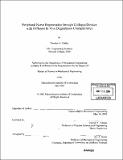Peripheral nerve regeneration through collagen devices with different in vivo degradation characteristics
Author(s)
Harley, Brendan A. (Brendan Andrew), 1978-
DownloadFull printable version (13.46Mb)
Other Contributors
Massachusetts Institute of Technology. Dept. of Mechanical Engineering.
Advisor
Ioannis V. Yannas.
Terms of use
Metadata
Show full item recordAbstract
In the United States more than 200,000 people are treated each year for peripheral nerve injuries that require surgery. Functional recovery of motor and sensory capability is limited following autograft, the most common procedure for peripheral nerve repair. Tubulation repair of a transected peripheral nerve presents an alternative to autograft, but has not yet shown the ability to satisfactorily restore lost function. A variety of degradable and non-degradable materials have been used to fabricate the tubes used to bridge the stumps of a transected nerve, and collagen tubes have been specifically shown to improve the quality of regeneration. The optimal characteristics for the tube have yet to be identified, and a collagen device that can be manipulated and optimized to improve functional peripheral nerve recovery is needed. The overall goal of this thesis was to fabricate and characterize a new collagen tube such that the tube characteristics and their effects on peripheral nerve regeneration can be closely studied, manipulated, and optimized. Following characterization of a homologous series of collagen tubes, each produced with a different density of crosslinks, the regenerative capacity of each member of the series of tubes was studied to determine the effects of device permeability, crosslink density, and in vivo tube degradation rate on peripheral nerve regeneration. It was first observed that the device permeability to cells and large soluble regulators significantly affected the quality of peripheral nerve regeneration, with the more permeable device (pore diameter 80 - 100 tm) (cont.) showing significantly improved regenerative capacity compared to a semi-permeable tube (pore diameter - 22 nm). It was then observed that the quality of nerve regeneration increases with an increase in tube degradation rate; however, after reaching a maximum at an intermediate degradation rate, the quality of nerve regeneration decreases gradually at increasingly higher tube degradation rates. The data indicate that the morphologic properties of the regenerated axons can be optimized by varying the in vivo degradation rate of the tube, and that tube degradation has a powerful effect on peripheral nerve regeneration.
Description
Thesis (S.M.)--Massachusetts Institute of Technology, Dept. of Mechanical Engineering, 2002. Includes bibliographical references (leaves 158-159).
Date issued
2002Department
Massachusetts Institute of Technology. Department of Mechanical EngineeringPublisher
Massachusetts Institute of Technology
Keywords
Mechanical Engineering.